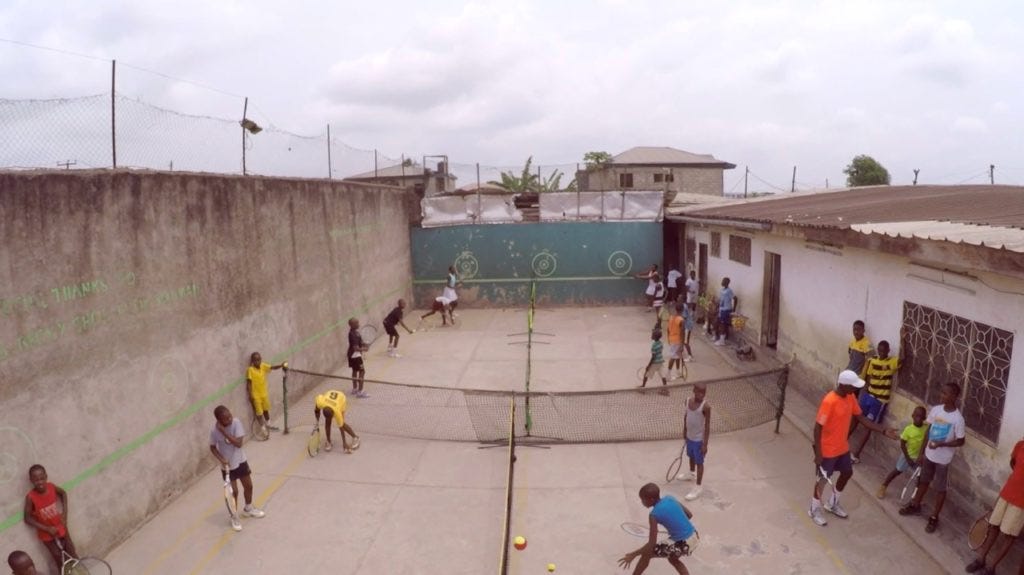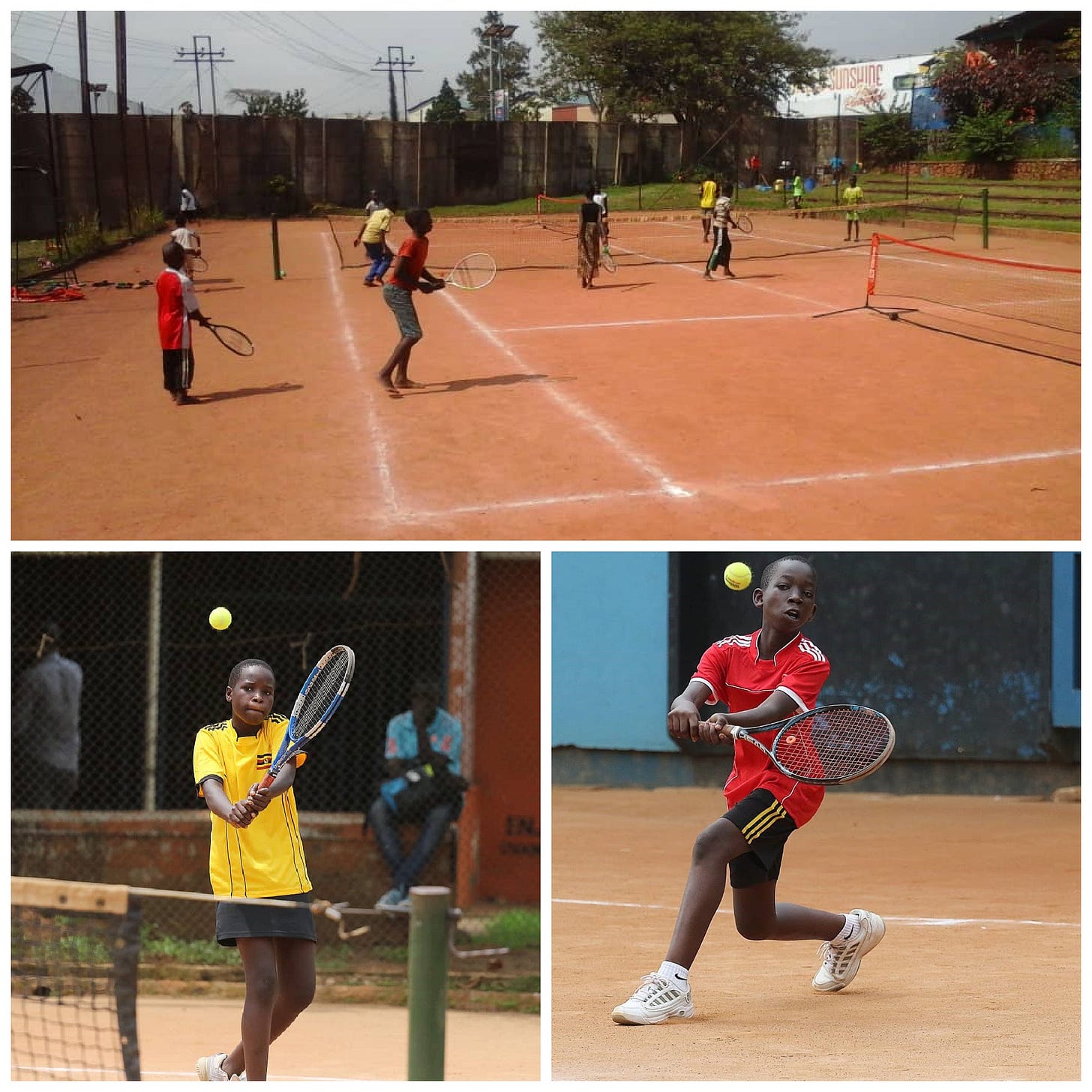Tennis Takes Root in Sub-Saharan Africa
With new ITF ranking systems and renewed interest, former pro players, such as Yannick Noah — and other professionals — are bringing tennis to the continent
Yannick Noah poses for a group photo with Cameroonian children at the Oyebog Tennis Academy. "Passion is stronger than anything magnificent isn't it?" Noah wrote on Instagram.
Before Arthur Ashe whizzed through the capital of Yaoundé, Cameroon on his second goodwill tour of sub-Saharan Africa in 1972 and discovered him hitting balls at a local hotel, Yannick Noah hardly knew that professional tennis took place, let alone Wimbledon, the French Open, or even the Grand Slams. Then age 12, Noah stood under five-feet tall and weighed less than 100 pounds, but Ashe saw his athleticism and his competitiveness immediately.
The U.S. champion also realized that Noah would likely have limited ability to develop his potential in Cameroon, where little coaching or competition existed. “We had just come into the tennis complex and I saw this diminutive, brown little figure playing tennis, and just hitting the hell out of the ball,” Ashe explained in a 1982 interview. “I was amazed that any kid, especially one so small, could be playing so well there in the middle of Western Africa.” Ashe made a call to Philippe Chatrier, then the president of the French Tennis Federation, and the young Noah was sent back to the country of his birth to train.
Arthur Ashe and Yannick Noah surround English player and instructor Adrian Stonebridge during the 1982 Davis Cup in Grenoble, France.
For many years, Noah’s professional commitment to give back remained at Roland Garros through his children’s charity Fête le Mur. “(The Cameroon Tennis Federation) want me to say they helped me. It is too late. I have no responsibility to a race or to a country. Just to my family,” Noah said early in his career. “There is no way I could have become a good player if I had stayed in Cameroon. I didn’t know anything about the tennis world… If I had stayed there, I might have been champion of Cameroon and nothing more.”
But things have changed dramatically for Noah and the sport in Africa since the early Open-era — and even in the last decade. While few flags from African countries line up next to players’ names in the top-100 — or even top-200 — in the ATP or WTA professional tennis tours, more and more African children have been “discovered” and sent to elite tennis academies in the United States, Canada and Europe.
Moreover, teaching pros have made a concerted effort to return to Africa to start their own local academies and NGOs to spread home-grown tennis across the African continent — and to keep it there. Noah, the 1983 Roland Garros champion, recently shared a video of dozens of kids bopping up and down as they slowly inched forward, waiting for their opportunity to hit a few balls on a makeshift court at the Oyebog Tennis Academy in Yaoundé with the quote, “Passion is stronger than anything — magnificent isn't it?”
Children running drills on the court of the OTA on a typical day in Central Cameroon.
Founded in 1999 by Cameroonian Joseph Oyebog, who climbed as high as No. 1187 in the ATP Doubles Rankings, the OTA was one of the first academies to serve underprivileged children in sub-Saharan Africa and has introduced more than 12,000 kids to tennis in Cameroon, according to the organisation’s website. “The programme is a safe haven for children; a place to go where they feel great about themselves,” Oyebog has said. In 2012, with a single donation Oyebog purchases a 16-acre plot of land 20 miles outside of Douala, the economic capital of Cameroon, to create a home and training ground for 38 promising young children from around the country, in addition to the 100 children who come to Oyebog’s Souza campus to train daily.
But Oyebog isn’t the only show in Africa. In Uganda, one of the historically more stable countries in Africa due to a decades-long autocracy, the Tennis Federation has accredited no fewer than five national tennis academies — the ROL Tennis Academy, the Prodigy Tennis Academy and the Tena Tennis Academy — to name a few, all with the same ultimate goal: to develop national and internationally ranked players with ITF, WTA and ATP world rankings and keep those player near home. But according to Ivan Kahangire, a former Ugandan cricket standout who now plays and teaches tennis, few young players’ parents can afford to pay “an average of $10 per day for the ITF Certified coach and the rented court.”
A day in the life of Tennis for all Uganda (TfAU), a tennis program that teaches youngsters in the African country tennis and life skills.
Last year, Kahangire registered Friends of Tennis Uganda (FoTU) to “sponsor other academies to be able to afford the same ITF certified trainers, or build them their own courts where they don’t have to pay every time they have to step on.” So far, one of FoTU’s main benefactor’s has been Tennis for All Uganda (TfAU), a program founded in 2012 by Vincent Muwereza and Julius Kobe, two friends who worked their way up to coaching from the position of “ball picker” for clients at the Lugogo Tennis Club, one of the more posh venues in the capital, Kampala.
For each session, Muwereza and Kobe use a local school’s dirt playground, which they drag to get rid of debris, then paint lines and place nets — an hour’s endeavour before any coaching. The duo is currently looking for about $3,000 to build a new tennis court and expand its high-performance academy. Meanwhile, Kahangire is looking to receive donations, racquets, shoes, balls and junior nets to nets to help TfAU and organizations like it.
While many teaching pros from Africa often settle in Europe, the U.S. or China to teach at the elite academies, such as IMG (Bollettieri) or Mouratoglou (the coach of Serena Williams), more and more are now working short stints abroad and returning home to places like Ghana or Senegal or to one of the ITF academies in Morocco or Kenya to teach. In turn, Western players and African ex-pats have established NGOs, such as Tennis in Africa or Tennis without Borders to fund and supply students who would otherwise have to ball-pick to earn court time and/or money for coaching, racquets, shoes and other.
A group of children in Uganda receive their basic instruction achievement certificates through Tennis for All Uganda (TfAU).
With the ITF’s recent announcement of a World Tennis Number — a single global tennis rating for players of all ages, genders and abilities — Kahangire expects the interest in African tennis to grow even greater.
“The plan is to think even bigger and create a sustainable tennis culture on the continent, that will not only produce world champions, but also create tennis followers/fans in the tens of thousands,” Kahangire says. “We already have an infrastructure created by soccer. Now, we just need to produce better, scalable and more impactful results, but we’re getting there.”
Friends of Tennis Uganda (FoTU), Tennis in Africa and Tennis without Borders is currently accepting donations of funds, junior nets and gently used and/or new court shoes and racquets. For more information, visit their websites, or leave a comment.







